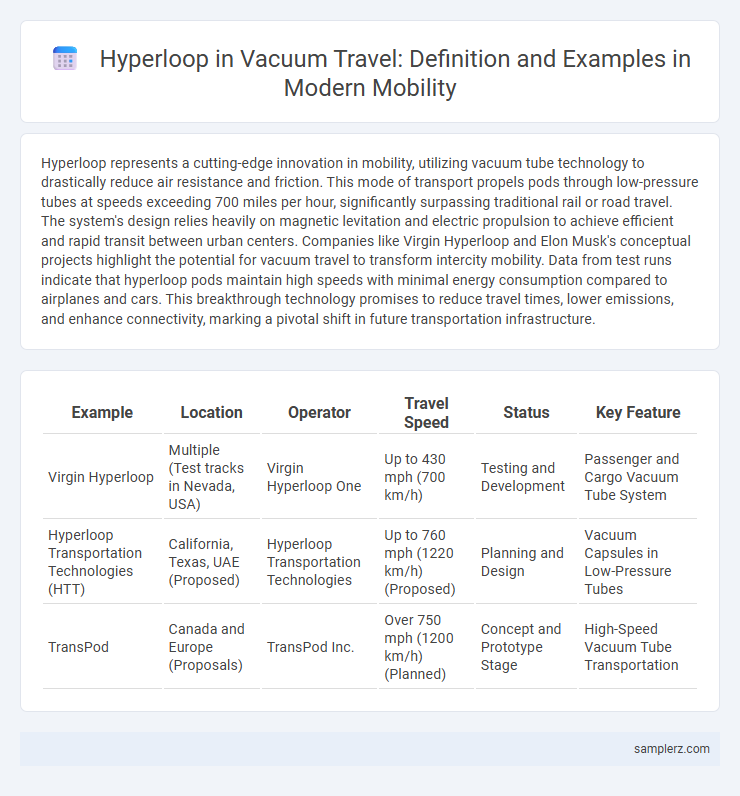Hyperloop represents a cutting-edge innovation in mobility, utilizing vacuum tube technology to drastically reduce air resistance and friction. This mode of transport propels pods through low-pressure tubes at speeds exceeding 700 miles per hour, significantly surpassing traditional rail or road travel. The system's design relies heavily on magnetic levitation and electric propulsion to achieve efficient and rapid transit between urban centers. Companies like Virgin Hyperloop and Elon Musk's conceptual projects highlight the potential for vacuum travel to transform intercity mobility. Data from test runs indicate that hyperloop pods maintain high speeds with minimal energy consumption compared to airplanes and cars. This breakthrough technology promises to reduce travel times, lower emissions, and enhance connectivity, marking a pivotal shift in future transportation infrastructure.
Table of Comparison
| Hyperloop Project | Location | Travel Concept | Top Speed (km/h) | Status | Operator / Developer |
|---|---|---|---|---|---|
| Virgin Hyperloop | USA (Nevada) & UAE (Dubai) | Passenger and Cargo in near-vacuum tubes | 1200 | Testing and Development | Virgin Hyperloop One |
| Hyperloop Transportation Technologies (HTT) | Global (Focus on USA, Europe, India) | Passenger Transit in low-pressure tubes | 1100 | Planning and Pilot Projects | HTT |
| TransPod | Canada and Europe | Passenger and Freight in vacuum-sealed tubes | 1200 | Design and Early Prototyping | TransPod Inc. |
| Zeleros Hyperloop | Spain | Passenger transport in partial vacuum environment | 1000 | Concept and Proof of Concept | Zeleros |
Introduction to Hyperloop Technology in Vacuum Travel
Hyperloop technology utilizes near-vacuum tubes to minimize air resistance, enabling high-speed travel exceeding 700 miles per hour. Magnetic levitation and low-pressure environments reduce friction, optimizing energy efficiency and passenger comfort. This innovative mobility system aims to revolutionize long-distance transportation with unprecedented speed and sustainability.
Key Principles of Vacuum-Based Hyperloop Systems
Vacuum-based hyperloop systems operate on the principle of drastically reducing air resistance by creating a near-vacuum environment within sealed tubes, allowing pods to travel at high speeds with minimal friction. Magnetic levitation and linear motors propel the pods, eliminating contact with the track and enhancing energy efficiency. Maintaining stable low-pressure conditions and ensuring airtight seals are critical to optimizing velocity and safety in vacuum hyperloop transportation.
Notable Hyperloop Projects Around the World
Notable Hyperloop projects worldwide include Virgin Hyperloop in the United States, which has successfully tested passenger pods in vacuum tubes, aiming to revolutionize high-speed travel. The Hyperloop Transportation Technologies (HTT) initiative in Europe plans to develop commercial routes connecting major cities at speeds exceeding 600 mph. Dubai's simulation project envisions integrating Hyperloop technology with existing transport infrastructure to dramatically reduce travel times across urban centers.
Virgin Hyperloop: Pioneering Vacuum Transit
Virgin Hyperloop is revolutionizing vacuum travel by developing a high-speed transportation system that uses magnetic levitation inside near-vacuum tubes to minimize air resistance. The technology enables pods to reach speeds of up to 600 miles per hour, significantly reducing travel time between major cities. This pioneering approach to hyperloop transit aims to create a sustainable, efficient, and future-forward mobility solution.
Elon Musk’s Hyperloop Concept and Early Prototypes
Elon Musk's Hyperloop concept revolutionizes vacuum travel by proposing a near-vacuum tube system that drastically reduces air resistance, enabling pods to travel at speeds exceeding 700 miles per hour. Early prototypes developed by companies like Virgin Hyperloop demonstrated magnetic levitation and capsule propulsion technologies, validating the feasibility of ultra-fast, energy-efficient ground transport. This innovative approach aims to transform regional mobility by shortening travel times and reducing carbon emissions compared to conventional rail and air travel.
Hyperloop Transportation Technologies: Major Achievements
Hyperloop Transportation Technologies has pioneered advancements in vacuum tube travel by developing high-speed pods designed to travel at speeds exceeding 700 mph within near-vacuum environments, significantly reducing air resistance. The company's collaborative projects with global partners have resulted in groundbreaking progress on scalable, sustainable infrastructure for urban and intercity mobility. Their patented linear magnetic acceleration systems and airlock technologies represent critical innovations driving the future of hyperloop transit solutions.
Comparative Analysis: Hyperloop vs Traditional Rail and Maglev
Hyperloop technology offers significantly faster travel speeds, reaching up to 760 mph, compared to traditional rail's average of 80-125 mph and Maglev's 270-310 mph. The vacuum tube environment reduces air resistance, resulting in higher energy efficiency and lower operational costs than Maglev, which relies on magnetic levitation without vacuum assistance. Infrastructure costs for Hyperloop remain uncertain but potentially lower due to smaller track footprints, contrasting with the extensive rail networks and costly magnets required for traditional and Maglev systems.
Environmental Impact and Sustainability of Hyperloop Vacuum Travel
Hyperloop vacuum travel significantly reduces carbon emissions by utilizing electric propulsion and minimizing air resistance, leading to lower energy consumption compared to traditional transport modes. The system's reliance on renewable energy sources enhances its sustainability, while enclosed tubes prevent external environmental disruption and noise pollution. Efficient land use and rapid transit times contribute to reduced urban congestion and associated environmental pressures.
Challenges and Limitations in Hyperloop Vacuum Development
Hyperloop vacuum technology faces significant challenges such as maintaining near-perfect vacuum conditions over long distances, which increases infrastructure complexity and costs. Material durability under low pressure and high-speed travel poses limitations to safety and system reliability. Furthermore, the integration of vacuum tubes with existing urban infrastructure remains a critical obstacle to widespread deployment.
Future Prospects for Hyperloop and Vacuum Mobility Technologies
Hyperloop and vacuum mobility technologies offer revolutionary prospects for ultra-high-speed transportation by drastically reducing air resistance and friction through near-vacuum environments. Companies like Virgin Hyperloop and Elon Musk's The Boring Company are advancing prototype development, targeting speeds exceeding 600 mph, which could cut travel times between major cities to under an hour. Future integration of smart infrastructure and energy-efficient propulsion systems promises to enhance sustainable urban mobility and redefine intercity transit globally.

example of hyperloop in vacuum travel Infographic
 samplerz.com
samplerz.com